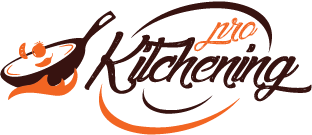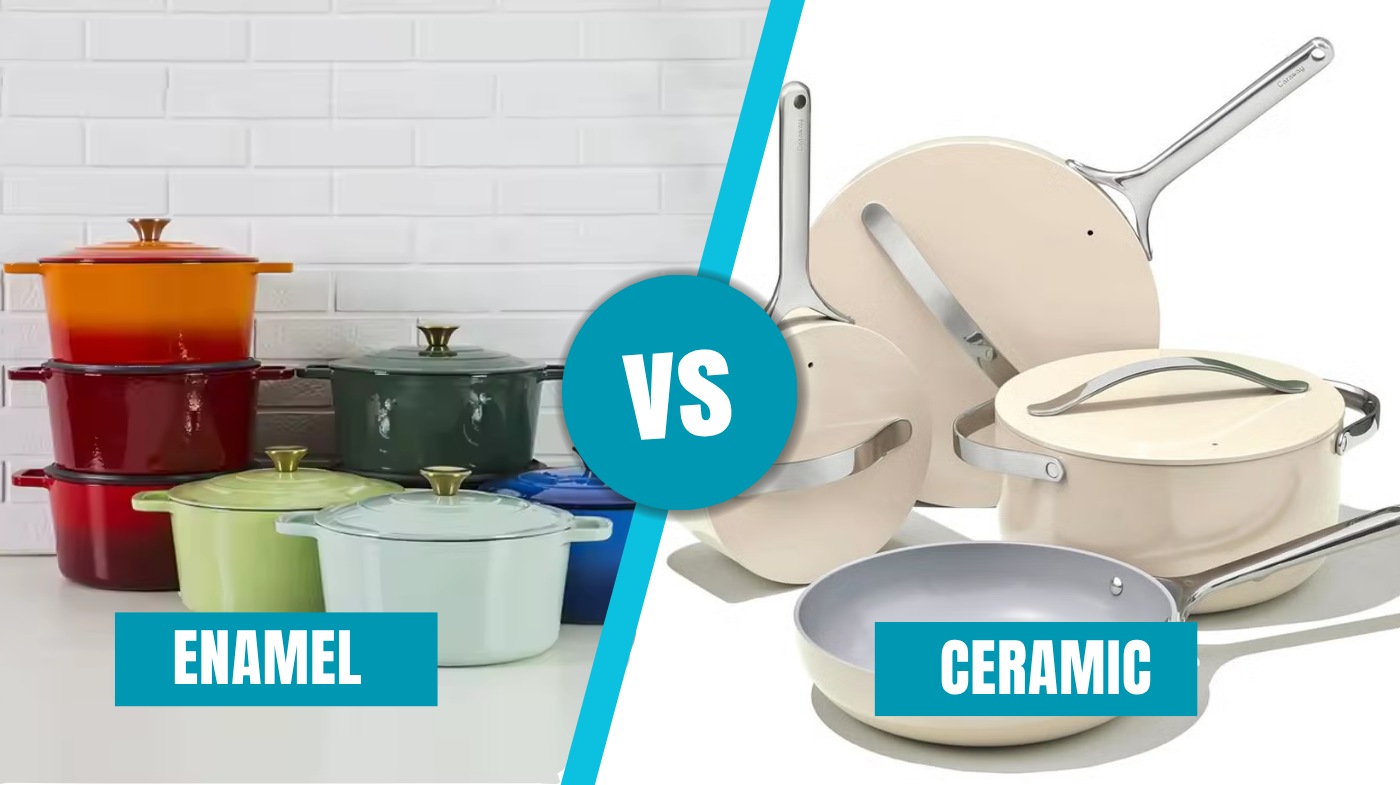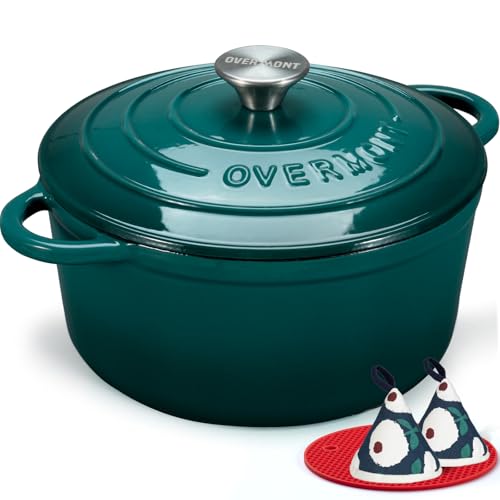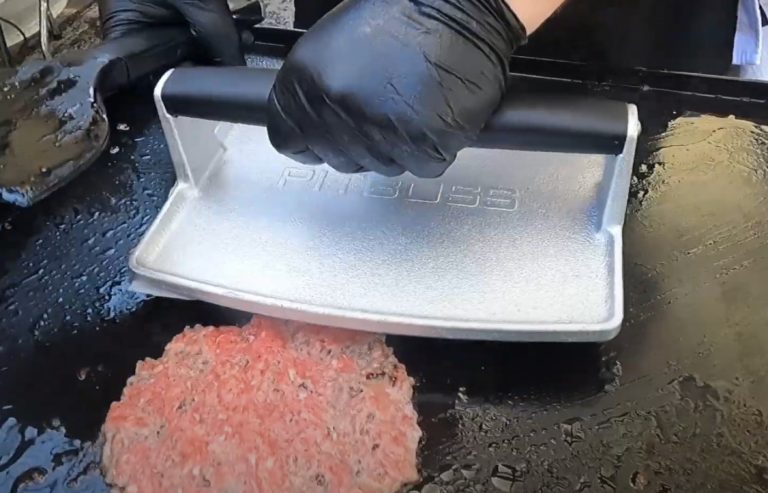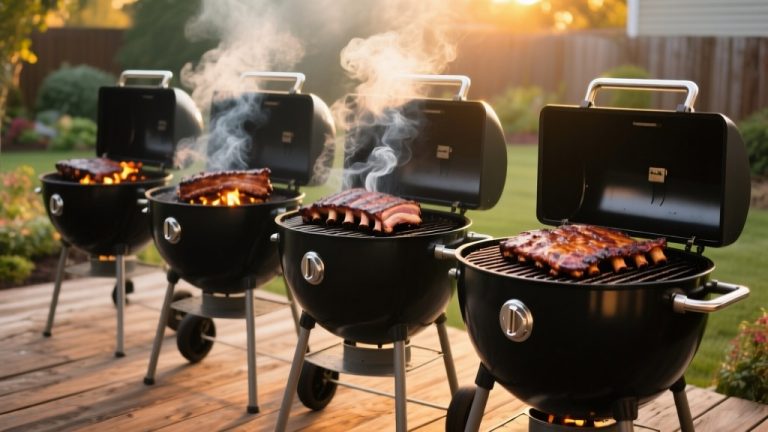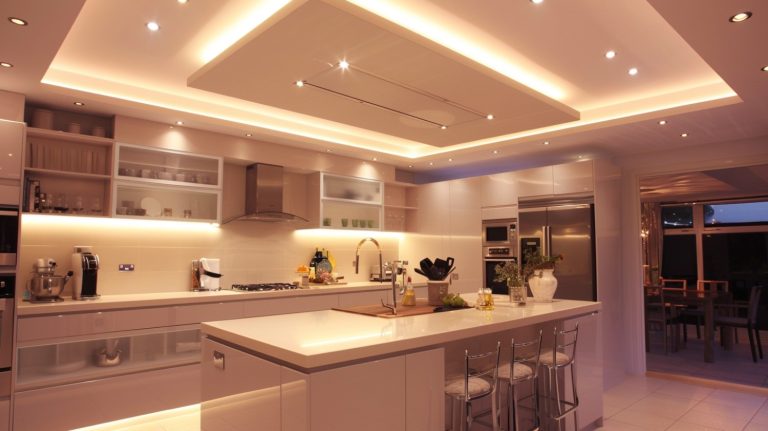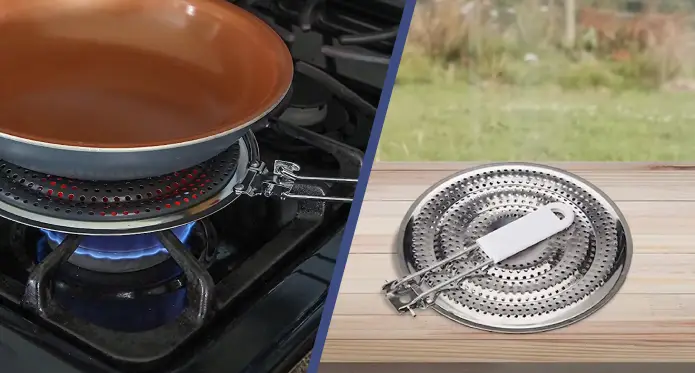Enamel vs Ceramic Cookware: Things to Know Before Buying
Choosing between enamel and ceramic cookware depends on your cooking needs: enamel offers superior heat distribution and durability with a heavyweight cast iron base, ideal for slow cooking, while ceramic heats faster, is lighter, and suits quick sautés but may wear faster.
Both are non-reactive and safe when undamaged, yet enamel stands up better to high heat and long-term use. If you want insights into maintenance, cost, and design differences, keep exploring these options carefully.
- 【Cast Iron Cookware Set 】This 8-piece cast iron pots and pans set is a must-have in your…
- 【What You Get?】Get a 10” Skillet for omelets & pancakes. Also included is an 8 – inch pan for…
- 【Hard-Coat Enamel】Our ceramic coated cast iron cookware flaunts beautiful enameled interiors and…
- Healthy Ceramic Cookware Set – Ceramic non-stick surface, safe and non toxic, free of PFOA, PTFE,…
- Natural Nonstick – Ceramic non-stick is healthier than Teflon coating! Scratch-resistant with…
- 14 Piece Pots and Pans Set Includes – 8 & 9.5 inch frying pan set, 12inch/5Qt saute pan with lid,…
Key Takeaways
- Enamel cookware has a cast iron or steel core with a glass coating, making it heavier and ideal for even heat distribution and slow cooking.
- Ceramic cookware is lighter, heats quickly, and is better suited for sautéing and frying but may heat less evenly than enamel.
- Both cookware types are non-reactive and safe, but damaged coatings can expose reactive metals and reduce safety.
- Enamel cookware lasts over ten years with proper care, while ceramic non-stick lasts 1-3 years and true ceramic 5-10 years.
- Ceramic offers more vibrant colors and modern designs, whereas enamel provides classic aesthetics with durable, long-lasting finishes.
Enamel vs Ceramic Cookware Comparison Table
| Feature | Enamel Cookware | Ceramic Cookware |
|---|---|---|
| Construction | Cast iron/steel core with glass coating | Clay-based or coated aluminum/steel |
| Weight | Heavier (5+ lbs typical) | Lighter and easier to handle |
| Heat Performance | Superior even heat distribution and retention | Quick heating but less even |
| Durability | 10+ years with proper care | 1-3 years (non-stick), 5-10 years (true ceramic) |
| Temperature Tolerance | Up to 850°F/450°C | Lower heat tolerance |
| Best For | Slow cooking, braising, searing | Quick sautéing, everyday cooking |
| Cost | Higher upfront, better long-term value | Lower initial cost, may need frequent replacement |
| Maintenance | Hand wash recommended, careful handling needed | Easier to clean, generally dishwasher safe |
Material Differences
While both enamel and ceramic cookware serve similar culinary purposes, their material compositions set them distinctly apart.
Enamel cookware features a powdered glass coating fused at high temperatures onto a cast iron or steel base, creating a non-reactive, corrosion-resistant surface ideal for acidic foods. This coating also provides excellent heat retention, making it suitable for slow cooking and simmering.
In contrast, true ceramic cookware is fashioned from clay-based materials hardened in furnaces, offering a smooth, non-reactive surface suitable for delicate ingredients.
Ceramic non-stick varieties utilize a silicon dioxide-based coating, which enhances versatility in colors and styles but generally shortens lifespan.
Both materials provide chemical resistance and safety, yet enamel’s robust metal base lends it greater durability.
You’ll find enamel cookware heavier due to its metallic core, whereas ceramic options tend to be lighter and more maneuverable, reflecting their distinct material properties and construction methods.
Heat Distribution and Cooking Performance
Because heat distribution is fundamental to cooking quality, understanding how enamel and ceramic cookware perform in this area is essential.
Enamel cookware provides superior, even heat distribution thanks to its enamel layer, ensuring consistent temperature control vital for slow cooking and delicate sauces.
Ceramic cookware heats quickly and retains heat efficiently but may show slight unevenness. Enamel cookware also requires careful handling to avoid chipping risk that can affect its heat distribution and longevity.
Consider these key points:
- Heat Management: Enamel excels in uniform heat retention; ceramic heats rapidly but can be temperature-sensitive.
- Cooking Techniques: Use enamel for braising and roasting; ceramic suits sautéing and frying due to its non-stick surface.
- Temperature Tolerance: Both withstand high temperatures, but enamel offers broader versatility across stovetops.
Durability and Lifespan Comparison
Heat management plays a significant role in cookware performance, but durability and lifespan can ultimately determine your investment’s value.
Enameled cookware, with its metal core and fused glass enamel coating, typically lasts over ten years if handled properly. This glass coating provides a smooth, non-porous surface that is easy to clean and helps prevent rust on the metal core.
Ceramic non-stick cookware, however, wears out within 1-3 years due to its fragile silica-based surface. True ceramic cookware offers 5-10 years but is less common.
Both require careful use to avoid damage like chipping or scratching, which drastically shortens their usability.
| Feature | Enameled Cookware | Ceramic Cookware |
|---|---|---|
| Material Base | Metal with enamel coating | Clay or ceramic |
| Lifespan | 10+ years | 1-3 years (non-stick), 5-10 years (true ceramic) |
| Durability Risks | Chipping, cracking | Scratches, thermal shock |
| Handling Required | Avoid metal utensils | Avoid abrasive tools |
| Robustness | High | Moderate |
Maintenance and Cleaning Tips
You’ll want to use gentle cleaning techniques tailored to each cookware type: enameled cast iron requires soft sponges and non-abrasive cleaners, while ceramic cookware tolerates mild soap and is generally dishwasher safe.
For enameled cast iron, it is best to hand wash with warm, soapy water and avoid citrus-based cleaners to preserve its finish and prevent damage to the enamel surface.
Avoid metal utensils on both surfaces to prevent scratches, but enameled cast iron demands more careful handling to preserve its finish.
Cleaning Techniques Comparison
Although both enamel and ceramic cookware require careful maintenance, their cleaning techniques differ markedly due to surface properties.
Ceramic’s smooth, non-stick surface generally allows for easy cleaning with gentle soap and soft sponges, avoiding abrasives to preserve the coating. This is because most ceramic cookware is an aluminum or stainless steel base with a ceramic coating.
Enameled cookware demands more attention, as its stickier surface often needs special cleaners and careful hand washing to prevent damage.
Follow these cleaning guidelines:
- Ceramic: Use mild detergent and soft cloths; avoid metal scrubbers and the dishwasher to extend lifespan.
- Enamel: Hand wash with gentle soap; use Bar Keeper’s Friend for stubborn stains; dry metal rims thoroughly to prevent rust.
- Both: Avoid bleach, baking soda abrasives, and sudden temperature changes to maintain surface integrity.
Utensil Usage Recommendations
Proper utensil selection plays an essential role in maintaining the integrity of both enamel and ceramic cookware surfaces. You should always use wooden, silicone, or nylon utensils, as they minimize scratching and preserve the non-stick coating.
Wooden spoons, spatulas, and chopsticks are especially recommended because they are safe to use and won’t damage the cookware surface.
Avoid metal utensils entirely—they cause deep scratches that expose the underlying metal, accelerating wear and reducing cookware lifespan. Also, steer clear of sharp-edged or high-heat plastic utensils to prevent melting or warping.
Before use, clean your utensils to remove abrasive particles, and inspect them regularly for damage like splinters or cracks to avoid contamination. Hand-wash utensils with mild soap and store them separately from cookware to prevent accidental scratching.
Consistent use of gentle utensils maintains non-stick efficiency, reduces cleaning time, and greatly prolongs your cookware’s service life.
Dishwasher Safety Guidelines
When caring for enamel and ceramic cookware, understanding dishwasher safety is crucial to preserving their surface integrity.
Although enamel cookware is often labeled dishwasher safe, frequent machine washing can cause chipping, discoloration, and thermal shock.
Similarly, ceramic cookware risks cracking and degradation due to harsh detergents and high temperatures in dishwashers. Dishwashers use harsh, enzyme-based cleaners that can damage ceramic coatings.
To maintain your cookware’s longevity, follow these critical guidelines:
- Always allow cookware to cool completely before washing to prevent thermal shock.
- Avoid abrasive cleaners and harsh detergents; opt for mild soap and soft sponges instead.
- Prefer hand washing over dishwasher use to protect non-stick coatings and prevent scratches caused by utensil contact or stacking.
Safety and Health Considerations
Because safety and health are paramount in choosing cookware, understanding the chemical composition and durability of enamel and ceramic surfaces is essential.
Enamel’s fused glass coating is non-reactive, preventing chemical leaching, while true ceramic cookware, made from clay without synthetic additives, contains no toxic metals or chemicals. Genuine porcelain enamel has been used since the 19th century with longevity and durability.
Enamel and true ceramic cookware are safe, non-reactive, and free from toxic metals or chemicals.
Both materials resist food absorption and odors, supporting hygienic cooking. You must avoid chipped or cracked surfaces, as damaged coatings expose reactive metals that may contaminate food.
Enamel withstands higher temperatures (up to 850°F/450°C) and resists warping, ensuring stability and safety during cooking.
Ceramic coatings vary in heat tolerance and degrade faster under high heat. Maintaining coating integrity and following proper use prevents health risks, making enamel and ceramic reliable, non-toxic choices for safe, health-conscious cooking.
Cost Analysis and Value for Money
Although ceramic cookware generally costs less upfront, evaluating value for money requires considering durability, performance, and maintenance.
Enameled cast iron commands a higher initial investment but offers exceptional longevity and heat retention, making it cost-effective over time. Its resistance to rust and corrosion also contribute to its lasting value.
Ceramic cookware, while easier to clean and less expensive initially, may lose its non-stick coating and require replacement sooner.
Consider these factors to assess value:
- Durability: Enameled cast iron resists wear and can last decades; ceramic coatings may fade or chip.
- Performance: Cast iron excels in heat retention and slow cooking; ceramic suits everyday quick meals.
- Maintenance: Both need gentle handling, but ceramic’s fragility increases replacement frequency.
Aesthetic Appeal and Design Options
You’ll find ceramic cookware offers a broader spectrum of vibrant colors and contemporary design styles, while enamel cookware leans toward classic aesthetics with durable finishes.
Both types come in various shapes and sizes, but ceramic sets often provide more ergonomic and lightweight options.
When considering brands and price points, ceramic cookware typically spans a wider range, giving you more flexibility to match your kitchen’s look and budget.
Additionally, ceramic cookware is versatile for use on gas, electric, and induction cooktops, making it adaptable to various cooking setups versatile for cooktops.
Color Variety Comparison
When selecting cookware that complements your kitchen’s aesthetic, enamel and ceramic options both offer appealing color varieties that enhance visual design.
Enamel cookware features a broad palette with a vibrant, glass-like finish, while ceramic cookware provides multiple hues such as white, cream, copper, light gray, and black, often tailored to match decor.
Consider these factors when choosing:
- Color Stability: Enamel resists scratches better and maintains color longer under heavy use; ceramic shows minimal fading but is less durable.
- Customization: Ceramic coatings offer more customization to fit specific aesthetics, whereas enamel generally adheres to standard market colors.
- Visual Impact: Both add decorative flair and can influence cooking ambiance, enhancing food presentation and tabletop appeal.
Design Styles Available
Beyond color variety, the design styles of enamel and ceramic cookware greatly influence their aesthetic appeal and functionality in your kitchen.
Enamelware excels with vintage charm, featuring marbled, floral, and retro patterns that suit farmhouse, rustic, and vintage-inspired kitchens. Its textured surfaces and solid whites provide tactile and minimalist options.
Ceramic cookware, conversely, emphasizes sleek, modern elegance with geometric patterns tailored for contemporary kitchens.
Both materials allow customization, including custom colors and monogramming, enhancing personalization.
Enamelware’s historical German roots and 19th-century popularity add heritage value to its designs, making it collectible.
When selecting cookware, consider how enamel’s nostalgic, textured appeal contrasts with ceramic’s streamlined, modern aesthetic to complement your kitchen’s style and your functional preferences effectively.
Choosing the Right Cookware for Your Needs
How do you determine the best cookware for your culinary needs? Start by evaluating your cooking style: enameled cookware excels in high-heat applications like searing and slow cooking, tolerating temperatures up to 450°C, while ceramic cookware suits gentle cooking with consistent heat distribution and a non-stick surface.
Keep in mind that EGC materials are corrosion-resistant, making them ideal for acidic and salty foods. Additionally, understanding the heat retention properties of your cookware can significantly impact cooking outcomes.
Consider durability—enameled cookware is highly abrasion and corrosion-resistant, offering longevity, whereas ceramic coatings may chip or wear over time.
Enameled cookware offers superior durability, resisting abrasion and corrosion, while ceramic coatings may chip or wear over time.
Evaluate maintenance; ceramic is easier to clean, but enameled requires careful handling to avoid chipping. Factor in safety; both are generally safe, though damaged ceramic coatings risk chemical leaching.
Finally, balance aesthetics and budget: ceramic offers vibrant colors at a lower upfront cost, while enameled delivers classic style with long-term investment value. Choose based on performance, durability, and your culinary priorities.
Frequently Asked Questions
Can Enamel Cookware Be Used on Induction Cooktops?
Yes, you can use enamel cookware on induction cooktops if it has a cast iron base. The ferromagnetic cast iron core allows it to work efficiently with induction technology. To confirm, simply test the cookware with a magnet—if it sticks firmly, it’s compatible.
Just be cautious to avoid enamel chipping and prevent the enamel bottom from fusing to the glass surface of the cooktop during use or cleaning.
Does Ceramic Cookware React With Acidic Foods?
You don’t have to worry about ceramic cookware reacting with acidic foods. Its non-reactive surface guarantees no chemical interaction with ingredients like tomatoes or citrus, preserving flavor and appearance.
Ceramic’s purity and high-temperature baking eliminate impurities, so it won’t leach metals into your food. This makes it a safe, durable choice for cooking acidic dishes without compromising taste or safety.
Are Enamel Pots Suitable for Outdoor Camping?
You’ll find enamel pots highly suitable for outdoor camping due to their durability and resistance to corrosion and scratches.
They’re lightweight, portable, and fireside ready, so you can safely use them over campfires. Enamelware handles acidic foods well and offers non-stick properties, making cooking and cleaning easier in rough conditions. Just be cautious to avoid chipping, and clean them regularly to maintain performance and longevity.
How Heavy Is Enamel Cookware Compared to Ceramic?
Think of enamel cookware as the heavyweight champion in your kitchen ring. It’s considerably heavier due to its cast iron core, often tipping scales around 5 pounds or more, like a Lodge Dutch Oven at 5.42 lbs. Ceramic cookware, by contrast, is lighter and easier to handle, though exact weights depend on brand and size.
Can Ceramic Cookware Be Used Under a Broiler?
You shouldn’t use most ceramic cookware under a broiler because it can crack or shatter from the intense heat, often exceeding 450°F.
Ceramic non-stick coatings may degrade or discolor, reducing cookware lifespan. Instead, opt for broiler-safe materials like cast iron or stainless steel.
Some specialized ceramic baking dishes are designed for broiler use, but standard ceramic cookware generally isn’t built to withstand those temperatures safely.
Choose Wisely: Your Perfect Cookware Awaits
Choosing between enamel and ceramic cookware is like selecting the right tool for a craftsman’s masterpiece. Enamel offers robust durability and even heat, while ceramic provides a sleek, non-reactive surface with gentle warmth.
By understanding their distinct strengths and maintenance needs, you can craft culinary success tailored to your kitchen’s demands. Equip yourself wisely, and your cookware will become the reliable foundation upon which every great meal is built.
- HEALTHY CERAMIC SKILLET – Made of natural ceramic, free of intentionally added PFOA, PTFE, PFAS,…
- SUPER NONSTICK – The ceramic surface is smooth and highly nonstick, allowing eggs to effortlessly…
- INDUCTION COMPATIBLE – Stainless steel bottom makes this pots and pans set suitable for all…
- Outstanding Heat Mastery: Crafted with precision, Overmont premium enamel cast iron ensures…
- Perfectly Preserved Flavors: Say goodbye to dry and overcooked meals! With our innovative design,…
- Versatile Culinary Wonder: From stewing and boiling to roasting and frying, this single cookware…
Last update on 2026-01-10 / Affiliate links / Images from Amazon Product Advertising API
